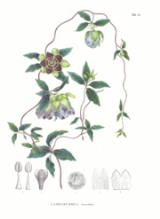
Codonopsis lanceolata
Encyclopedia
Codonopsis lanceolata is a flowering plant. It originates from China and Japan. It is a variety of bonnet bellflower
.
The roots are used in Korean cuisine, where it is called deodeok (더덕).
It is used in Korean dishes such as deodeok kimchi
(더덕김치), deodeok jeon
(더덕전), deodeok gui
(더덕구이), deodeok saengchae
(더덕생채), and changui (찬구이).
Codonopsis lanceolata is also used as a natural medicine.
A hardy perennial climber that grows up to 1.5m tall. It has bell shaped flowers that are purple inside and flowers from August to September and the seeds ripen from September to October. The flowers are hermaphrodite and are pollinated by bees and wasps.
Specialist info (Cultivation, Propagation method, Pests, treatments, uses, historic)
It grows in moist areas in woodland on low hills or mountains at an elevation of 200-1600m.
The plant likes light and medium well drained soils with plenty of moisture with a neutral to acidic ph. It likes full sun to semi-shade.
The leaves and roots of the plant are edible raw or cooked. The plant has many medical uses and is used to treat lung abscesses, milk-flow obstruction and inflamed boils among many others.
Slugs and snails eat young growth.
The plant is propagated by seed which is surface-sown onto ericaceous compost. Division is also possible although great care must be taken as the plant hates root disturbance.
The plant is grown commercially in Hoengseong County, Gangwon Province
, South Korea, where it is an important part of the local agriculture. However, many South Koreans grow a small amount in personal gardens.
Codonopsis
Codonopsis is a genus of flowering plant within the family Campanulaceae. It is allied to Campanumoea and Leptocodon, and some authors suggest that Codonopsis should include these genera...
.
The roots are used in Korean cuisine, where it is called deodeok (더덕).
It is used in Korean dishes such as deodeok kimchi
Kimchi
Kimchi , also spelled gimchi, kimchee, or kim chee, is a traditional fermented Korean dish made of vegetables with varied seasonings. There are hundreds of varieties of kimchi made with a main vegetable ingredient such as napa cabbage, radish, green onions or cucumber. It is the most common...
(더덕김치), deodeok jeon
Jeon (food)
Jeon , buchimgae, jijimgae, or jijim refer to many pancake-like dishes in Korean cuisine. It has been also called jeonyueo or jeonyuhwa, especially in Korean royal court cuisine. Sometimes, jeonya is used as an abbreviated term for the two...
(더덕전), deodeok gui
Gui
Gui or guee is a generic term to refer to grilled dishes in Korean cuisine. These most commonly have meat or fish as their primary ingredient, but may in some cases also comprise grilled vegetables or other vegetarian ingredients. The term derives from the verb, "gupda" in Korean, which literally...
(더덕구이), deodeok saengchae
Saengchae
Saengchae is a kind of Korean salad generally consisting of uncooked mixed seasonal vegetables such as radishes and other ingredients such as chicken or jellyfish....
(더덕생채), and changui (찬구이).
Codonopsis lanceolata is also used as a natural medicine.
A hardy perennial climber that grows up to 1.5m tall. It has bell shaped flowers that are purple inside and flowers from August to September and the seeds ripen from September to October. The flowers are hermaphrodite and are pollinated by bees and wasps.
Specialist info (Cultivation, Propagation method, Pests, treatments, uses, historic)
It grows in moist areas in woodland on low hills or mountains at an elevation of 200-1600m.
The plant likes light and medium well drained soils with plenty of moisture with a neutral to acidic ph. It likes full sun to semi-shade.
The leaves and roots of the plant are edible raw or cooked. The plant has many medical uses and is used to treat lung abscesses, milk-flow obstruction and inflamed boils among many others.
Slugs and snails eat young growth.
The plant is propagated by seed which is surface-sown onto ericaceous compost. Division is also possible although great care must be taken as the plant hates root disturbance.
The plant is grown commercially in Hoengseong County, Gangwon Province
Gangwon-do (South Korea)
Gangwon-do is a province of South Korea, with its capital at Chuncheon. Before the division of Korea in 1945, Gangwon and its North Korean neighbour Kangwŏn formed a single province.-History:...
, South Korea, where it is an important part of the local agriculture. However, many South Koreans grow a small amount in personal gardens.

